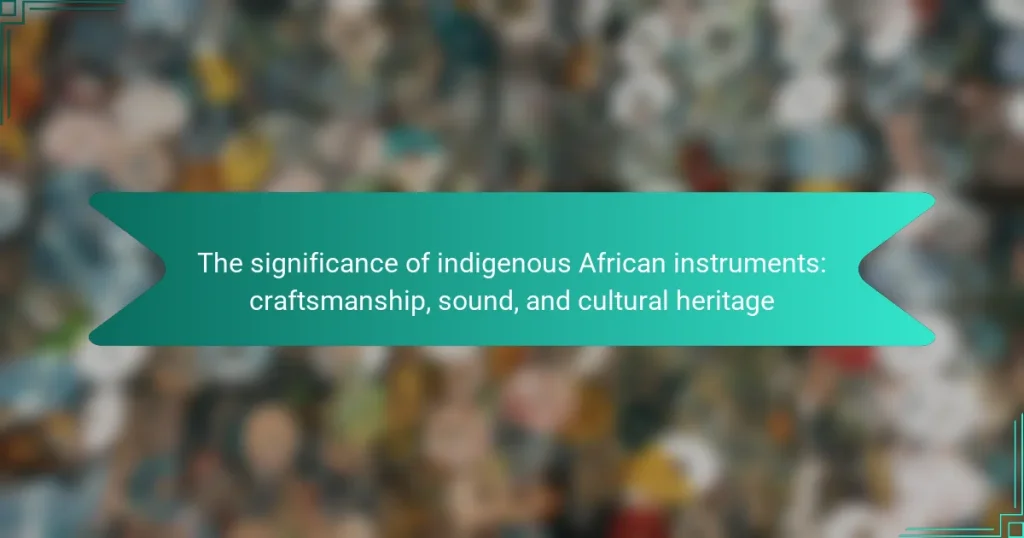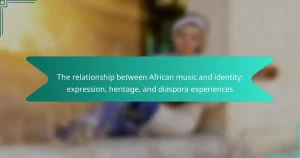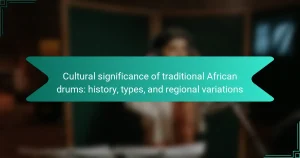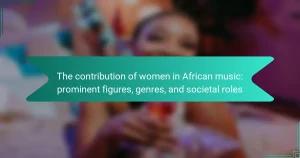Indigenous African instruments are traditional musical tools that embody the continent’s rich cultural diversity and history. These instruments, including drums, flutes, string instruments, and percussion devices, are essential in rituals, celebrations, and storytelling, each carrying unique meanings within their communities. The article explores the significance of these instruments in shaping cultural identity through their distinct sounds and craftsmanship, highlighting challenges such as the decline of traditional skills, globalization, lack of financial support, cultural appropriation, and environmental issues that threaten their production. By examining these aspects, the article underscores the importance of preserving indigenous African instruments as vital components of cultural heritage.
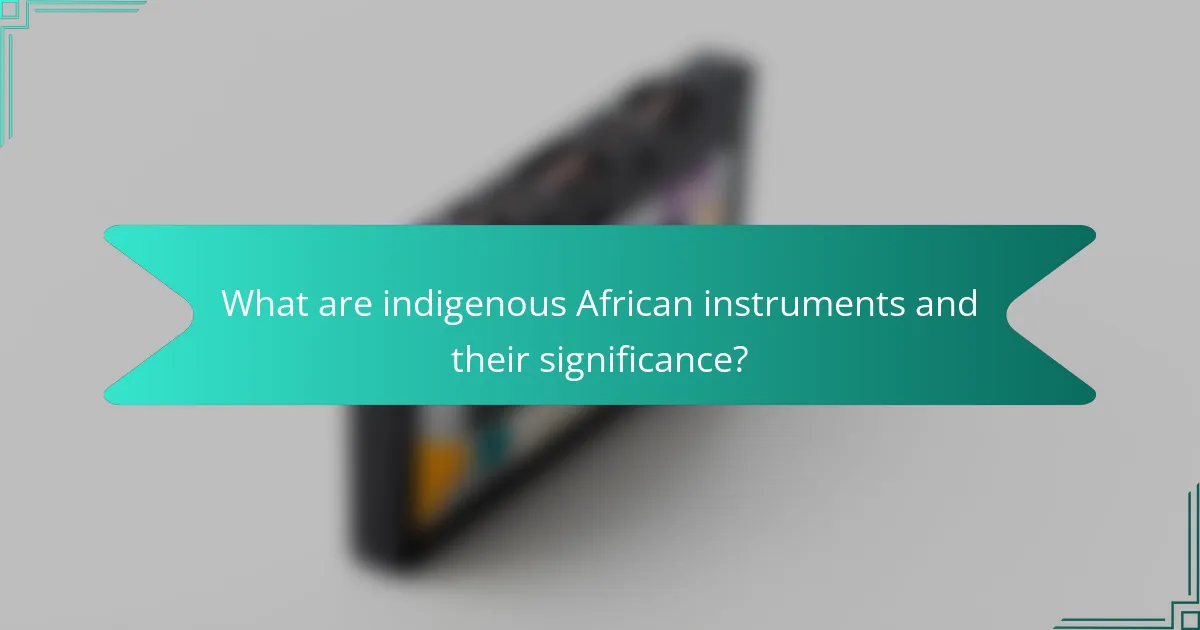
What are indigenous African instruments and their significance?
Indigenous African instruments are traditional musical tools that reflect the continent’s diverse cultures and histories. These instruments include drums, flutes, string instruments, and percussion devices. They play a vital role in rituals, celebrations, and storytelling. Each instrument carries unique meanings and functions within specific communities. For example, the djembe drum is used in West African ceremonies and promotes social cohesion. The kora, a stringed instrument, serves as a storytelling device in the griot tradition. These instruments are often handcrafted using local materials, showcasing the craftsmanship of artisans. Their sounds are integral to cultural identity and heritage, connecting generations through music.
How do indigenous African instruments reflect cultural heritage?
Indigenous African instruments reflect cultural heritage through their design, sound, and use in traditional practices. Each instrument is often handcrafted using local materials, showcasing the artistry and skills passed down through generations. The sounds produced by these instruments are deeply tied to specific cultural rituals, ceremonies, and storytelling traditions. For example, the djembe drum is used in communal gatherings and celebrations, emphasizing social cohesion. Instruments also carry historical significance, often representing the identity and beliefs of various ethnic groups. The unique rhythms and melodies associated with these instruments convey cultural narratives and values. Thus, indigenous African instruments serve as vital expressions of cultural heritage, preserving and transmitting the essence of diverse African communities.
What are the historical contexts of these instruments?
Indigenous African instruments have deep historical contexts rooted in cultural practices and societal functions. These instruments date back thousands of years and were integral to rituals, celebrations, and storytelling. They often reflect the values, beliefs, and traditions of various ethnic groups. For example, the djembe drum originated in West Africa and was traditionally used in communal gatherings and ceremonies. Historical records indicate that these instruments were crafted using local materials, showcasing the craftsmanship of artisans. Additionally, oral histories and anthropological studies highlight the role of music in preserving cultural heritage across generations. The significance of these instruments can be traced through archaeological findings and ethnographic research, underscoring their importance in African identity and community cohesion.
How do different regions influence the types of instruments used?
Different regions influence the types of instruments used through cultural traditions and available materials. For example, West African regions often utilize drums made from animal skins and wood. This is due to the prominence of drumming in their musical heritage. In contrast, East African regions may favor string instruments like the kora, reflecting their unique musical styles and social contexts. The availability of local materials also shapes instrument construction. Bamboo is commonly used in the production of flutes in various regions, owing to its abundance. Additionally, climatic conditions can affect instrument durability and sound quality. For instance, arid regions might lead to the development of more resilient instruments. Historical trade routes also facilitated the exchange of musical ideas and instruments, further diversifying regional practices.
What craftsmanship techniques are used in creating these instruments?
Indigenous African instruments are created using various craftsmanship techniques. These techniques include hand-carving, which shapes wood into specific forms. Artisans often use traditional tools, such as chisels and knives, to ensure precision. Another technique is skin stretching, used for drums, where animal hides are meticulously prepared and attached. Additionally, artisans employ weaving methods for instruments like the kora, incorporating natural materials. Each technique reflects cultural significance and heritage. Historical practices have been passed down through generations, preserving the authenticity of the instruments. The craftsmanship not only creates sound but also embodies stories and traditions of the community.
What materials are commonly used in indigenous African instrument making?
Indigenous African instrument making commonly utilizes materials such as wood, animal skins, metal, and gourds. Wood is often sourced from local trees, providing the body for instruments like drums and xylophones. Animal skins, such as goat or cowhide, are used for drum heads, contributing to the sound quality. Metal is frequently employed in the creation of bells and other percussion instruments. Gourds serve as resonators in string instruments and are integral to many traditional designs. These materials are chosen for their availability and acoustic properties, reflecting the cultural heritage of various African communities.
How do traditional methods of craftsmanship vary across cultures?
Traditional methods of craftsmanship vary significantly across cultures due to differing historical contexts, materials, and techniques. In Africa, craftsmanship often involves communal practices and the use of locally sourced materials like wood, metal, and animal skins. For example, the making of traditional instruments, such as the djembe, relies on specific regional woods and techniques passed down through generations. In contrast, Asian cultures may emphasize intricate detailing and use of natural dyes, as seen in Japanese lacquerware. European craftsmanship often highlights precision and industrial techniques, evident in fine furniture making. Each culture’s unique environment shapes its craftsmanship, influencing the tools, skills, and artistic expressions employed.
What roles do indigenous African instruments play in community life?
Indigenous African instruments play vital roles in community life. They serve as tools for cultural expression and storytelling. Instruments like the djembe and kora are often used in communal gatherings and rituals. These gatherings reinforce social bonds and shared identities. Music created by these instruments is integral to celebrations, ceremonies, and rites of passage. Research shows that music fosters community cohesion and emotional connection. Additionally, indigenous instruments are used in educational contexts to teach history and traditions. They also promote intergenerational knowledge transfer within communities.
How are these instruments used in rituals and ceremonies?
Indigenous African instruments are integral to rituals and ceremonies. They are used to facilitate communication with spiritual entities. Different instruments serve specific purposes, like drumming to summon spirits or flutes to invoke peace. The sound produced is believed to carry intentions and prayers. Instruments also mark important life events, such as births, marriages, and funerals. Each instrument has cultural significance and is often crafted with traditional techniques. Their use fosters community bonding and cultural identity. Historical records show that these practices have been maintained for generations, highlighting their enduring importance.
In what ways do they contribute to social cohesion?
Indigenous African instruments contribute to social cohesion by fostering community identity and shared cultural practices. They serve as mediums for storytelling and the transmission of cultural values. Group performances create collective experiences that strengthen bonds among participants. These instruments often accompany rituals and ceremonies that unite individuals in significant life events. Their use in communal gatherings promotes interaction and collaboration among community members. Studies show that music can enhance emotional connections, leading to increased empathy and understanding. Furthermore, the craftsmanship involved in creating these instruments reflects cultural heritage, reinforcing pride and belonging within the community.
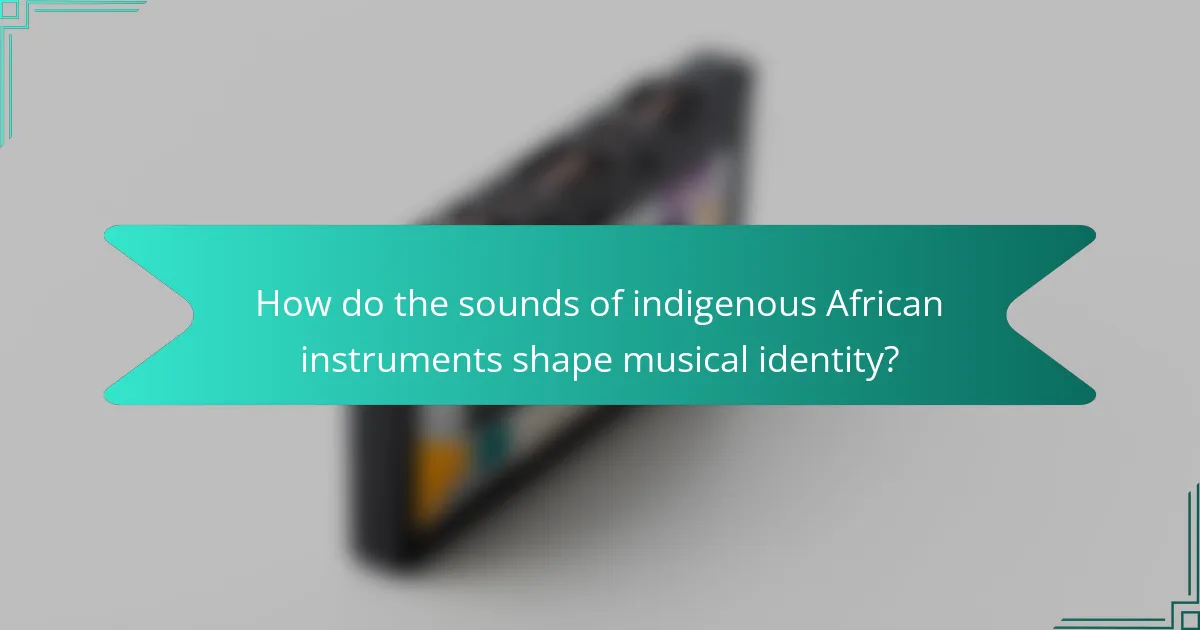
How do the sounds of indigenous African instruments shape musical identity?
The sounds of indigenous African instruments significantly shape musical identity by reflecting cultural heritage and community values. Each instrument carries unique tonal qualities that express specific emotions and narratives. For instance, the djembe drum’s rhythmic patterns often symbolize social cohesion and communal gatherings. Instruments like the kora blend melodic traditions with storytelling, reinforcing cultural identity. Studies indicate that these sounds foster a sense of belonging among community members. Furthermore, the instruments are often used in rituals and celebrations, further embedding them in the cultural fabric. Their distinct sounds can also influence contemporary music genres, showcasing the adaptability of African musical identity. Thus, indigenous instruments are crucial in shaping and maintaining cultural identity through their sounds.
What are the unique sounds produced by these instruments?
Indigenous African instruments produce a wide variety of unique sounds. Each instrument has distinct characteristics based on its design and materials. For example, the djembe creates a deep, resonant bass sound and sharp, high-pitched tones. The kora produces a melodic, harp-like sound, often described as ethereal. The mbira generates a bright, tinkling sound, which is both soothing and rhythmic. The shekere offers a percussive, rattling sound that adds texture to music. The ngoni has a warm, wooden tone, often used in storytelling. Each of these instruments contributes to the rich tapestry of African music. Their sounds reflect cultural heritage and craftsmanship, highlighting the importance of these instruments in community gatherings and rituals.
How do tuning systems differ among various instruments?
Tuning systems differ among various instruments based on their construction and cultural context. String instruments like the kora use a pentatonic scale, while wooden instruments like the mbira utilize a diatonic scale. Brass instruments such as trumpets are often tuned using equal temperament, allowing for flexibility in pitch. Percussion instruments may not have a fixed tuning system, instead relying on the player’s technique and the instrument’s design. The tuning of indigenous African instruments is often influenced by local musical traditions and the specific sounds desired. For instance, the tuning of the ngoma drum varies regionally, reflecting different cultural practices.
What role does improvisation play in the music created with these instruments?
Improvisation plays a crucial role in the music created with indigenous African instruments. It allows musicians to express individuality and creativity within traditional frameworks. Each performance becomes a unique experience, shaped by the interaction between musicians. This spontaneity enhances the emotional depth of the music. Historical contexts show that improvisation has been integral to African musical traditions for centuries. Instruments like the djembe and kora thrive on improvisational techniques. This practice fosters communal participation and connection among performers and audiences. Ultimately, improvisation is essential for preserving cultural heritage while encouraging artistic evolution.
How do indigenous African instruments influence contemporary music?
Indigenous African instruments significantly influence contemporary music by introducing unique sounds and rhythms. Instruments like the djembe and mbira add distinctive percussive elements. Their polyrhythmic patterns enrich musical compositions. Contemporary artists often incorporate these instruments to create fusion genres. For example, the use of the kora in popular music blends traditional melodies with modern styles. This integration fosters cultural appreciation and awareness. Research shows that artists like Beyoncé and Paul Simon have drawn inspiration from African musical traditions. The influence of indigenous instruments is evident in global music trends today.
What fusion genres have emerged from traditional sounds?
Fusion genres that have emerged from traditional sounds include Afrobeat, Reggae Fusion, and World Music. Afrobeat combines traditional African rhythms with jazz and funk elements. It originated in Nigeria in the 1960s, popularized by Fela Kuti. Reggae Fusion blends reggae with various genres like rock and hip-hop. This genre gained traction in the 1990s with artists like Shaggy and Sean Paul. World Music incorporates diverse musical styles from around the globe, often integrating traditional sounds with contemporary influences. These genres exemplify how traditional sounds can evolve and influence modern music landscapes.
How are these instruments represented in modern media?
Indigenous African instruments are represented in modern media through various forms such as music, film, and visual arts. These instruments are often featured in documentaries that highlight their cultural significance. Music videos frequently showcase traditional instruments, blending them with contemporary genres. Films may include authentic soundtracks that utilize these instruments to enhance storytelling. Social media platforms also play a role in promoting these instruments, with artists sharing performances and tutorials. The representation often emphasizes the craftsmanship involved in creating these instruments. Additionally, cultural festivals broadcasted online celebrate these instruments, showcasing their historical context. This multifaceted representation helps preserve and promote African cultural heritage globally.
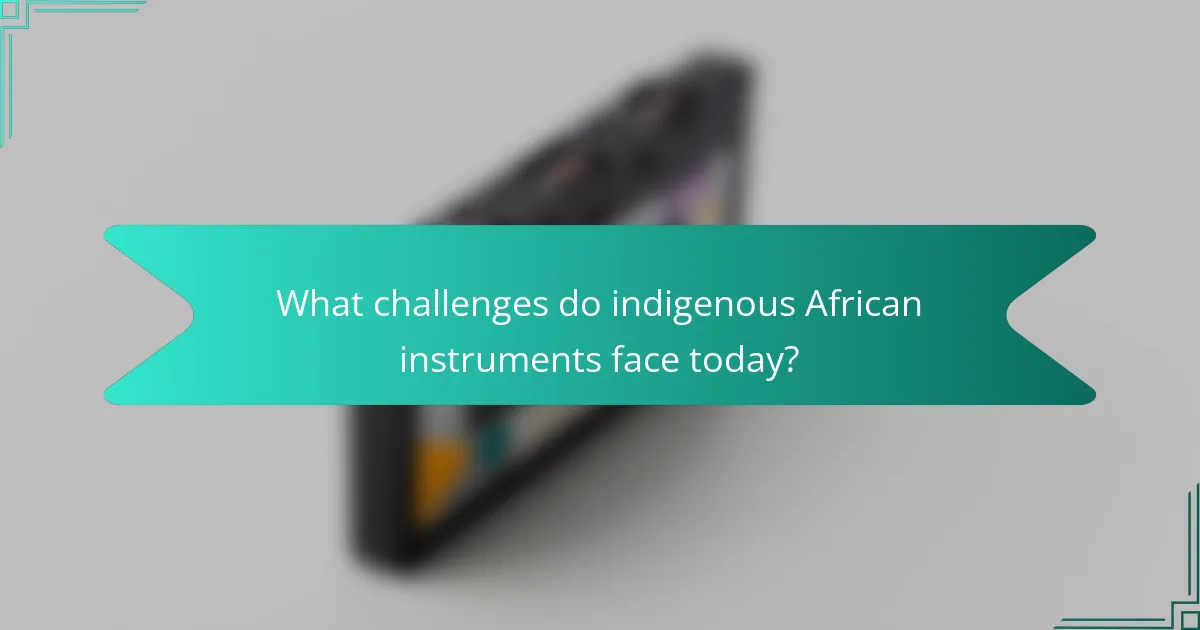
What challenges do indigenous African instruments face today?
Indigenous African instruments face several challenges today. One major challenge is the decline in traditional craftsmanship. Many skilled artisans are aging, and younger generations are not learning these skills. This leads to a loss of authentic instrument production.
Another challenge is the globalization of music. Western music dominates the market, overshadowing indigenous sounds. This results in reduced demand for traditional instruments.
Additionally, there is a lack of financial support for musicians and artisans. Many struggle to sustain their craft without adequate funding or resources.
Cultural appropriation is also a concern. Indigenous music and instruments are often used without proper acknowledgment of their origins. This can undermine the cultural significance of these instruments.
Lastly, environmental issues impact the availability of materials. Deforestation and climate change threaten the resources needed to craft these instruments.
How is globalization impacting the preservation of these instruments?
Globalization is both positively and negatively impacting the preservation of indigenous African instruments. On one hand, globalization facilitates the sharing of knowledge and techniques across cultures. This exchange can lead to a revival of interest in traditional craftsmanship. For example, workshops and online platforms allow artisans to learn from each other.
On the other hand, globalization can lead to cultural homogenization. Many traditional instruments may be overshadowed by popular global music trends. This can result in reduced demand for indigenous instruments. As a consequence, some artisans may abandon traditional practices for more commercially viable options.
Additionally, increased access to global markets can threaten the authenticity of these instruments. Mass production may replace unique, handcrafted items. This shift can dilute the cultural significance and craftsmanship associated with indigenous instruments. Thus, globalization presents a complex challenge to the preservation of these cultural artifacts.
What efforts are being made to promote and protect indigenous music?
Efforts to promote and protect indigenous music include cultural preservation initiatives and educational programs. Governments and organizations are establishing grants to support indigenous artists. Many communities are documenting traditional music practices through recordings and archiving. Festivals and cultural events are being organized to showcase indigenous music. Collaborative projects between indigenous musicians and contemporary artists are also gaining traction. Legal frameworks are being developed to protect indigenous intellectual property rights. Research studies are being conducted to understand the impact of music on cultural identity. These combined efforts ensure the survival and appreciation of indigenous music traditions.
How do economic factors affect the craftsmanship of these instruments?
Economic factors significantly influence the craftsmanship of indigenous African instruments. Financial resources determine the availability of quality materials. High-quality wood, animal skins, and metals are often expensive. Limited access to these materials can lead to a decline in craftsmanship quality. Economic conditions also affect artisans’ ability to invest in tools and training. Without proper tools, the precision and detail in craftsmanship may diminish. Furthermore, market demand influences the types of instruments produced. If demand decreases, artisans may prioritize quantity over quality to sustain income. Historical data shows that economic downturns correlate with reduced craftsmanship in various regions. Ultimately, economic stability is crucial for maintaining high standards in instrument craftsmanship.
What can be done to ensure the sustainability of indigenous African instruments?
To ensure the sustainability of indigenous African instruments, it is essential to promote education and awareness. Educational programs can teach younger generations about the cultural significance and craftsmanship of these instruments. Community workshops can facilitate hands-on learning experiences. Collaboration with local artisans can help preserve traditional techniques. Additionally, documenting the history and techniques of instrument-making can safeguard knowledge for future generations. Support for local musicians can create demand for these instruments. Financial incentives for artisans can encourage continued craftsmanship. Finally, integrating these instruments into contemporary music can enhance their relevance in modern culture.
How can communities engage in preserving their musical heritage?
Communities can engage in preserving their musical heritage by actively documenting traditional music practices. This includes recording performances and collecting oral histories from elder musicians. Workshops can be organized to teach younger generations about indigenous instruments and their significance. Collaborations with local schools can integrate music education focused on traditional styles. Festivals celebrating local music can raise awareness and encourage participation. Community radio stations can broadcast traditional music, fostering appreciation. Partnerships with cultural organizations can support preservation initiatives. These actions contribute to maintaining the cultural identity and legacy of indigenous African music.
What role do educational programs play in promoting awareness?
Educational programs play a crucial role in promoting awareness of indigenous African instruments. They educate individuals about the craftsmanship and cultural significance of these instruments. Through workshops and classes, participants learn about traditional techniques and the history behind each instrument. This knowledge fosters appreciation and respect for the cultural heritage associated with these musical tools. Furthermore, educational programs often involve community engagement, allowing participants to experience the instruments firsthand. Research shows that such programs can increase cultural awareness and preservation efforts. For instance, the “African Music and Cultural Heritage” initiative has successfully raised awareness among youth about the importance of indigenous instruments.
What are practical ways to support indigenous African musicians and artisans?
Purchase their music and artworks directly from them. This ensures they receive fair compensation. Attend live performances and local markets to engage with them. Promote their work on social media platforms to increase visibility. Collaborate with them on projects that highlight their cultural heritage. Provide funding or resources for workshops to enhance their skills. Support organizations that advocate for their rights and cultural preservation. Educate others about the importance of indigenous African music and craftsmanship.
Indigenous African instruments are traditional musical tools that embody the continent’s rich cultural heritage and craftsmanship. This article explores their significance in rituals, storytelling, and community life, highlighting unique instruments such as the djembe and kora. It examines the historical contexts, craftsmanship techniques, and materials used in their creation, as well as the role these instruments play in social cohesion and cultural identity. Additionally, it addresses contemporary challenges, the impact of globalization, and efforts to promote and preserve these vital cultural artifacts.
